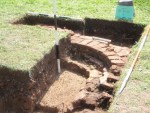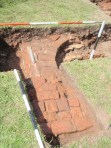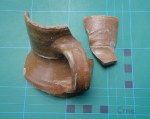22 Jul 2012
Festival of British Archaeology, Forty Hall, Day 6

The British summer finally lived up to its name today; fierce sunshine at times making digging uncomfortable. Fortunately there wasn't too much heavy work to do and we were again treated to unexpected and enigmatic archaeology.
Yesterday's extension into the dark "occupation" layer revealed yet another unexpected, curvilinear wall. This wall abuts the east end wall of the building, which we also located, and curves in the direction of yesterday's very substantial wall in the middle of the trench.

We established that this big wall's foundations run underneath the east end wall -- meaning that the big wall must pre-date the smaller wall -- but by how much earlier is not clear (it could be just days or weeks earlier).

As for dating evidence, we still have precious little to go on. The "occupation" layer did produce a handful of bones, and we also recovered a stoneware jug rim and handle from another context. The jug is a German import, and like a lot of utilitarian stoneware pottery may not be closely datable.
The final interpretation of the building is that it was a long thin L shaped structure, the north west end of which was open and saw heavy cart traffic. This end of the building was probably a barn and had gaps in the walls for ventilation, indicating an agricultural process at this end such as threshing.
The east end of the building turned not quite 90 degrees and had (probably a row) of round brick recesses which probably held large wooden bins for grain storage. There were probably other agricultural and semi-industrial activities going on at this end of the building, such as brewing, which required a very substantial brick wall reinforcement.
This was all probably built around 1657, after the palace's acquisition and demolition by Nicholas Rainton (junior), and was itself finally demolished some time later to make way for today's lime tree avenue.
As ever, this is an intermediate interpretation and will likely be refined as the all-important post-excavation work progresses. The results of this and our final conclusions will be published first in a formal report and will be summarised in the society news bulletin.